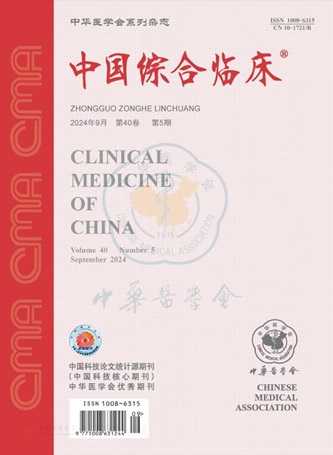血液成分输注联合重组活化因子VIIa治疗心脏手术后严重活动性出血的疗效评价
引用次数: 0
摘要
目的评价成分输血联合重组活化因子Ⅶa(rFⅦa)治疗心脏手术后严重活动性出血的疗效及并发症。方法选择大连医科大学第一附属医院2015年7月至2017年5月收治的50例心脏手术后严重活动性出血患者,采用随机数表法将其分为GR组(组分输血联合rFⅦa)和GA组(组份输血联合氨甲环酸),每组25例。在入院时(D1)、停止体外循环后(D2)以及用药后2小时(D3)、6小时(D4)和12小时(D5)筛查弥散性血管内凝血(DIC)的变化。分析两组在D1、D2、D3、D4和D5各时间点的活化部分凝血活酶时间(APTT)、国际标准化比值(INR)、纤维蛋白原、血红蛋白和血小板的差异。同时比较两组患者术后引流、术后输血、术后血浆输注量、术后机械通气时间、ICU留置时间、30d死亡率及并发症。结果两组APTT、INR、纤维蛋白原、血红蛋白和血小板均有显著性差异(均P 0.05),但在D3时间点,GR组APTT明显短于GA组((50.3±6.6)s vs.(60.1±6.5)s,P=0.027),在D4时间点GR组INR也明显低((1.3±0.3)vs.(1.5±0.3),P=0.041),GR组和GA组治疗后红细胞输注量((3.2±1.0)U vs.(4.1±1.0)U,P=0.005)、新鲜血浆输注((303.2±98.5)ml vs.(469.6±190.5)ml,P=0.000)、术后24小时引流量((519.9±107.5)ml vs(657.2±100.1)ml,P=0.000)均显著减少,差异有统计学意义。结论血液成分输注联合rFⅦa可显著改善心脏手术后严重活动性出血患者的APTT和INR,同时可减少红细胞输注量和血浆输注量。关键词:心脏外科手术;术后出血;重组活化因子Ⅶa;输血;心脏病本文章由计算机程序翻译,如有差异,请以英文原文为准。
Effect evaluation of blood component transfusion combined with recombinant activated factor VIIa in treatment of severe active hemorrhage after cardiac surgery
Objective
To evaluate the efficacy and complications of component blood transfusion combined with recombinant activated factor Ⅶa(rFⅦa)in treatment of severe active hemorrhage after cardiac surgery.
Methods
Fifty patients who suffered from severe active hemorrhage after cardiac surgery were selected from the First Affiliated Hospital of Dalian Medical University from July 2015 to May 2017.All patients were divided into GR group(component blood transfusion combined with rFⅦa)and GA group(component blood transfusion combined with tranexamic acid)by random number table method, 25 cases in each group.The changes of disseminated intravascular coagulation (DIC) were screened on admission(D1), after cessation of cardiopulmonary bypass(D2), and 2 h (D3), 6 h (D4) and 12 h (D5) after medication.The difference of activated partial thromboplastin time (APTT), international normalized ratio (INR), fibrinogen, hemoglobin and platelet of the two groups at each time point of D1, D2, D3, D4 and D5 were analyzed.Meanwhile, the postoperative drainage, postoperative blood transfusion, postoperative plasma transfusion volume, postoperative mechanical ventilation time, ICU retention time, the 30 d mortality and complications were compared between the two groups.
Results
There were significant differences in APTT, INR, fibrinogen, hemoglobin and platelet between the two groups (all P 0.05), but at D3 time point, APTT in GR group was significantly shorter than that in GA group((50.3±6.6)s vs.(60.1±6.5)s, P=0.027), and INR in GR group at D4 time point was also significantly lower ((1.3±0.3)vs.(1.5±0.3), P=0.041). In addition, the amount of red blood cells transfusion after treatment in GR group and GA group ((3.2±1.0)U vs.(4.1±1.0)U, P=0.005), the amount of fresh plasma transfusion ((303.2±98.5) ml vs.(469.6±190.5) ml, P=0.000), the amount of 24 h drainage after operation ((519.9±107.5) ml vs.(657.2±100.1) ml, P=0.000)were significantly decreased, the differences were statistically significant.
Conclusion
Blood component transfusion combined with rFⅦa can significantly improve APTT and INR of severe active hemorrhage after cardiac surgery, at the same time, it can reduce the amount of red blood cells transfusion and plasma transfusion.
Key words:
Cardiac Surgical Procedures; Postoperative Hemorrhage; Recombinant activated factor Ⅶa; Blood transfusion; Cardiac disease
求助全文
通过发布文献求助,成功后即可免费获取论文全文。
去求助
来源期刊
CiteScore
0.10
自引率
0.00%
发文量
16855
期刊介绍:
Clinical Medicine of China is an academic journal organized by the Chinese Medical Association (CMA), which mainly publishes original research papers, reviews and commentaries in the field.
Clinical Medicine of China is a source journal of Peking University (2000 and 2004 editions), a core journal of Chinese science and technology, an academic journal of RCCSE China Core (Extended Edition), and has been published in Chemical Abstracts of the United States (CA), Abstracts Journal of Russia (AJ), Chinese Core Journals (Selection) Database, Chinese Science and Technology Materials Directory, Wanfang Database, China Academic Journal Database, JST Japan Science and Technology Agency Database (Japanese) (2018) and other databases.

 求助内容:
求助内容: 应助结果提醒方式:
应助结果提醒方式:


